ETHICS NOTE: To conduct this interview, I was given access to a temporary closed beta for Dawn of War 3. I independently decided to pre-order the game with my own money based on my experiences in the beta. No other compensation was related to the production of this piece.
I’ve been following the development of Dawn of War III with a mixture of interest and, well, a bit of apprehension. The Dawn of War series is one of my all-time favorite RTS franchises, and as excited as I’ve been to jump back into a Dawn of War game, the latest entrant has felt like a pretty radical departure from Relic’s first two RTS forays into the Warhammer universe. As a fan of Dawn of War I and II, I was honestly a little concerned that such a departure might remove what I loved about the original games.
So, when I got the opportunity to speak with Game Director Philippe Boulle about the Dawn of War III, I went into the conversation with a pretty specific mission: to have him put this latest Dawn of War in its historical context. Clearly, choices were made in the development of DAWN OF WAR3 that resulted in a departure from the previous titles. But, to me, there were elements that just as clearly seemed to be drawn from the lessons of past Relic RTS titles.
Phil was a gracious guide as I jumped around from topic to topic, asking about Dawn of War I’s core systems one minute, and then changing abruptly to ask about Dawn of War II’s hero mechanics the next. He was very animated as we talked, able to speak articulately and in depth about every design question I asked, often covering topics before I brought them up. As he was my guide through the history of the franchise (and Relic’s vision for its future), let me be yours.
“No One Chops Wood in Warhammer” – Franchise Foundations

My first question took us back beyond Mr. Boulle’s tenure at Relic, to the original Dawn of War. I was wondering what elements from their first games were still considered today. “We have inherited information about Dawn of War” he told me, and elements of its design have remained staples throughout all of Relic’s games “We didn’t want peons or workers. That didn’t have a place in this universe”.
Numbered high amongst Relic’s initial goals were encouraging players to push out on the map “Its economy was based around map control, meant to represent tactical interest points like in the tabletop game.” This was, of course, fairly obvious and foundational, building up the basics for my overall line of inquiry. “It’s all been gamified” said Boulle “Obviously, no one is going around planting flags all over the map. But in Company of Heroes and Dawn of War, we wanted it to be clear what you were fighting over.”
I followed up by asking about base management in the original Dawn of War: what surprised Relic about it when players got their hands on it? What were they hoping to see that never materialized, or what unexpected behavior materialized once players got to explore the game’s systems? “It was a lot more static than we’d hoped” said Boulle. “The possibility was there, but it was just too efficient to capture the points near your base and fortify [them]. Other points on the map felt too optional.” He added that in the expansions, they experimented with adding functionality to the Listening Posts, adding incentives to capture more of them.

Our conversation moved naturally to the Necrons from Dawn of War’s Dark Crusade expansion. Not only were they my favorite classic Dawn of War faction, but they served an illustrative purpose regarding the utility of Listening Posts. “Necrons were, ultimately, a success because they had real thematic unity” Boulle told me. “They used the economy differently, they did production differently. It made them feel… neat. But their metagame, being outside the requisition economy, that in particular just wasn’t successful in the long term.”
The factions in Dawn of War I and its expansions allowed Relic to play around with mechanics that interacted with the play space in unique ways. It was important to Relic (and has remained important across the franchise) that it was obvious you weren’t playing one of the other races: unique racial mechanics is a core design philosophy across all of the Dawn of War and Company of Heroes titles. “In Dawn of War III, the Orks have an additional resource to extract, and the Eldar have their Webway Portal Network. That gives them a very different relationship with the map than the other factions. It’s some ways similar to Dawn of War I, but in that game it was almost never used. It was not a huge advantage. Now [In Dawn of War III] we see players using the building teleporting a lot.”
Control Points
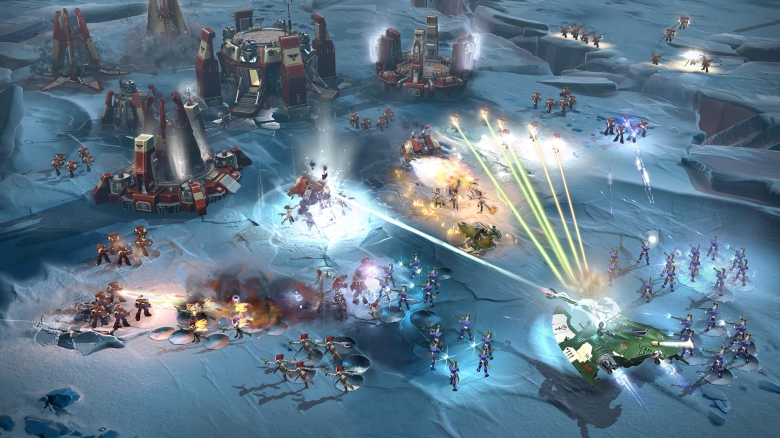
In previous Dawn of War games, there are lots of different kinds of point: Requisition points, Power Nodes, Victory Points, Relics, et cetera. In Dawn of War III, it seemed to me they were all done away with in favor of just one type of meta-point. Phil pointed out to me that I was a bit off base with that assessment. “There’s not just one type of point. They’re basically similar, but they vary in the types of sub-node they have. Some have an Elite Points Generator, some have a different mix of point type. We wanted to harmonize the systems, wanted players to perform just one type of action to retrieve resources.”
Phil noted that in Dawn of War II, Relic felt that players didn’t end up feeling a strong ownership of their points. They wanted to bring that feeling forward from Dawn of War I, where building and upgrading a Listening Post conferred a sense of ownership and weight to territory control.
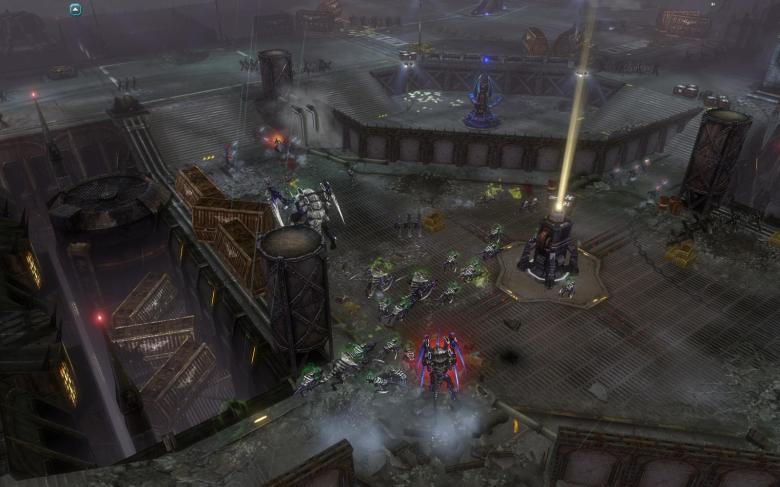
In previous games, said Phil, the various actions that players performed on their points felt disjoined. Relic wanted to streamline the system. But the system wasn’t just streamlined: there are some important differences in Dawn of War III. “It started in Dawn of War II, but in Dawn of War III, the team owns the resource points. You can capture the point and build the Listening Post, I can upgrade the node. There are other subtle changes, too. In Dawn of War I and II, just capping a point gave you resources. Now, you have to upgrade the point to get the benefits. We wanted to make capping a point more of an investment. It’s non-trivial.”
He continued “You have to start from scratch. You can’t just steal your opponent’s resource points. You have to kill all of their nodes before you take it.”
My takeaway from this exchange was that Relic has put a lot of thought and effort into creating their resourcing system, more than I had given them credit for prior to speaking with Phil. The requirement to empty out an enemy resource point before utilizing it is actually pretty friendly to the defending player: it’s a much bigger task to completely capture and start using a resource point than it is to defend it and rebuild. There’s more nuance to the system in general than I’d feared there would be. I was afraid that they’d dumbed the system down considerably by moving to only one type of resource point. The reality is thankfully a far more nuanced and balanced system.

He also mentioned that they’d taken some lessons from Company of Heroes 2 “The other big change was moving away from Victory Points in match play.” This one pricked my ears up, as I am in general a pretty big advocate for Victory Point-based systems in RTS design. “This was an interesting mode” he said “but… it wasn’t about blowing shit up. And Dawn of War is about blowing shit up. Victory Points created this premium of building up around the point to create an unbeatable wall, and we wanted to… encourage an aggressive situation that had an explosion at the end.”
I’ll be honest; I kind of do miss Victory Points. I feel like these systems have a lot to offer. But without going too far down a rabbit hole, I think that as long as the system forces players out onto the map, allows for the enemy player to be an obstacle instead of the objective, allows back-and-forth play and minimizes snowballing, it’s hitting the right notes for me.
There and Back Again? A Look At the Departures from Dawn of War II
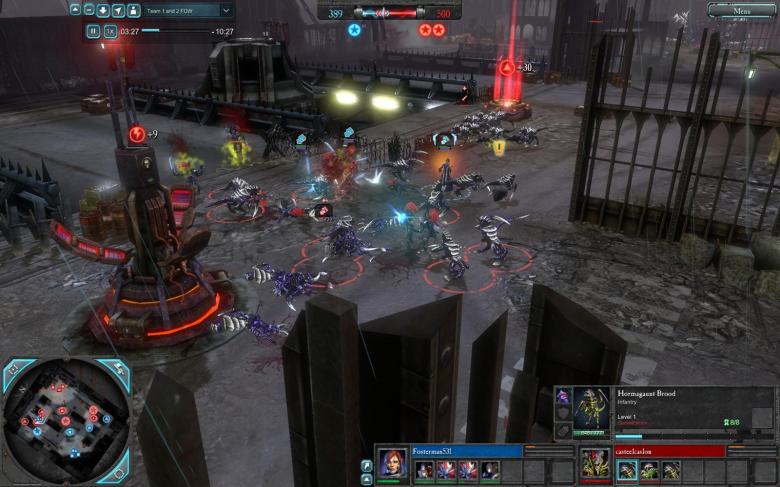
I’ll make no bones about it, I’m one of the people who found Dawn of War II to be a more compelling and enjoyable game than Dawn of War. There’s a couple of us out there. I was a bit confused, then, when I initially learned that Dawn of War III would be see base building return, and I made a point to ask Phil about this reversal.
“We made the decision to do away with base building in Dawn of War II, principally out of a desire to double down on the focus on units, on the front line. In retrospect, we felt it took away more in depth than it added in simplicity.” Phil noted that the lack of production queues, in particular, became a defining aspect of Dawn of War II, and Relic really wanted to recapture some of that feeling from Dawn of War I. They wanted to return to a less linear pacing system, and wanted to add in more opportunities for harassment.

Phil also talked about units. “Units in Dawn of War II are not disposable in the least. Map control is less important in terms of resource points, et cetera. It was a lot more about keeping units alive. The whole dynamic became about the scarcity of units.” Ultimately, said Boulle, that dynamic was one they wanted to move away from. “Unit control has its role, but the loss of a couple of squads isn’t going to cripple you in the long term – we wanted you to be able to come back. In the early prototypes, this was pushed further. We had to come back from that. Units were too disposable and too easy to replace. It was an iterative process, getting to where we ended up.”
Moving Forward: Bases, Phases, and Elite Resource

Connecting the past Dawn of War games to the present, Philippe talked about one big departure from past titles: the free forward building of troop structures. “Originally we weren’t sure if that was going to stay. But we kept it when we saw that it created these interesting possibilities. There’s a predictable risk/reward dilemma in building out on the map. You can reinforce more quickly, but you’re more exposed. Writ large, the player is encouraged to play out in the battlefield and not be chained to a base. And that’s what we wanted.”
He continued, “It makes perfect sense in retrospect, but it created this larger-order scouting. You know where the enemy base is, but you don’t know where they’re building their units. Where are reinforcements coming from? What area of the map is more important to them? It’s a good feeling when you scout out an enemy position and you’re able to capitalize on that,”

From there, the conversation drifted to one of Dawn of War III’s new features, not present in previous titles: combat escalation phases. This has a subtle but profound impact on multiplayer matches, and Phil was happy to take me through the finer points of this system. “Pacing is always important for multiplayer, and we spent extra attention on pacing. In part, we wanted to escalate to the big battles: this plays into what we call ‘dead man walking syndrome’ – where you lose the game way before you’re actually defeated. So, we settled on this system of phases. Escalation affects, basically, 3 separate things: it affects the health and firepower of objectives and Listening Posts. This means Listening Posts are easier to deal with in the early game. It also affects resource rate: resources come in faster with each escalation phase.”
He continued “It also reduces refunds.” I had to stop here and ask him about refunds: I was unaware of the existence of such a system. He explained “In the early game – the first two phases – when you lose units, you recoup some of their cost. So, there’s time-based advantages to killing enemy units, but not an irrevocable advantage. We joke about it, and say that playing RTS is like playing soccer, but when you score the opposing team also loses a player.”

This actually hit me really deep. This is a succinct observation that drives into the heart of my dissatisfaction with a lot of RTS games. I actually wrote a lengthy article on my blog recently about the whole concept of the slippery slope, and hearing Mr. Boulle talk about similar though processes going into the development of Dawn of War III had a big impact on me.
Phil went on “We wanted to create a space where there was more forgiveness in the early game. Escalation phases allow for a limited early game and but have players still end up with big armies. Without escalation, we found that either the early game is too short, or you never get to the end game. Neither was what we wanted. Tanks at 2 minutes is, well, fun, but not a sustainable multiplayer experience.”
“This is also a mechanic that scales with experience. When you first play it, it’s not something that you need to pay attention to, but it just naturally helps. As you get more skilled, it’s something you want to pay attention to though. Escalation phases have meaning to experienced players. They might hold off for the next phase to pursue a strategy, or try to take action before the next phase hits.”
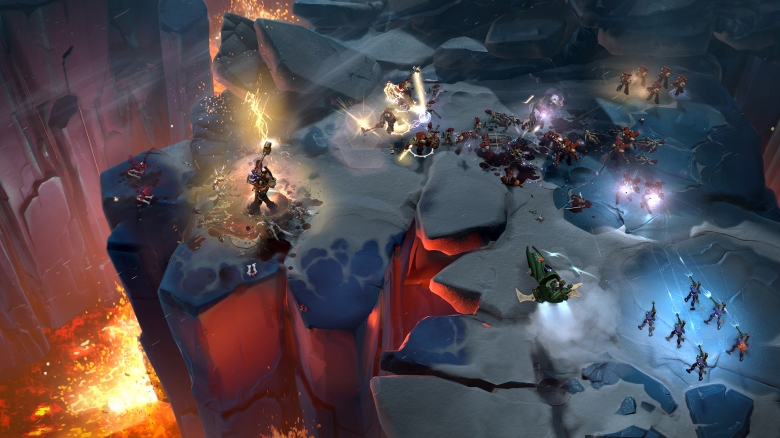
Escalation phases are something that was not seen much in RTS until recently, but more games are taking stabs at this sort of model. Eugen and Paradox’s new wargame Steel Division will also feature an escalation system, though the mechanics of escalation in Dawn of War III are quite different. As both a player and a designer, I personally feel that these systems are quite clever. They help maintain constant pacing and allow for targeted balance: with escalation, you can separately and specifically target balance changes at the early, mid, and endgame, which is a powerful tool to ensure a compelling experience in all stages of a multiplayer match. I’m looking forward to getting more experience with Dawn of War III’s escalation phase system, and exploring how it impacts match progression.
Spinning the Dream

I rounded up by asking Phil what he would say to fans of the previous Dawn of War titles that had some apprehensions about the direction of the third game.
“Creatively, we didn’t set out to replace either other game. Both games are still out there and playable, and still excellent. We did set out to bring some of the best elements of previous titles together into a new game, and create a new feeling for our audience. We didn’t set out to make Dawn of War One Plus Plus, or Dawn of War Two Plus Plus.” He noted that previous titles had some really compelling elements and that some things about their latest game were designed to fulfill similar player goals “The Hero/Elite Economy in part exists to scratch some of the same itch that was scratched in Dawn of War II. It’s not dependent on basebuilding, it’s mostly time-based. Strategic choice comes down to loadout, like Hero wargear in Dawn of War II, and build order. Do I want to bring in an early hero? These are decisions that will feel familiar to Dawn of War II players. Really, the optimal way to play is less about the hero in isolation, and more about how the army interacts with the hero. That said, hero versus hero interactions definitely happen in Dawn of War III, and should really feel pleasantly familiar to Dawn of War II players.”

I came out of this conversation feeling more positive about Dawn of War III than I had going in. As a longtime player of Dawn of War II, I was concerned about what I saw as a departure from Relic’s tried-and-true design philosophies. I was concerned about their decision to use a MOBA-ish system of towers instead of control points, and about the re-institution of base building mechanics. But Phil’s explanation for those design decisions, and his descriptions of the game’s systems in gestalt kind of led me to rethink my stance and re-evaluate the game.
I’m excited for another chance to get myself elbows-deep into Dawn of War III’s systems, and weigh the merits of Relic’s systems with fresh eyes. Thanks for reading, and Phil, thanks for taking the time to speak with me about all of the Dawn of War III titles.

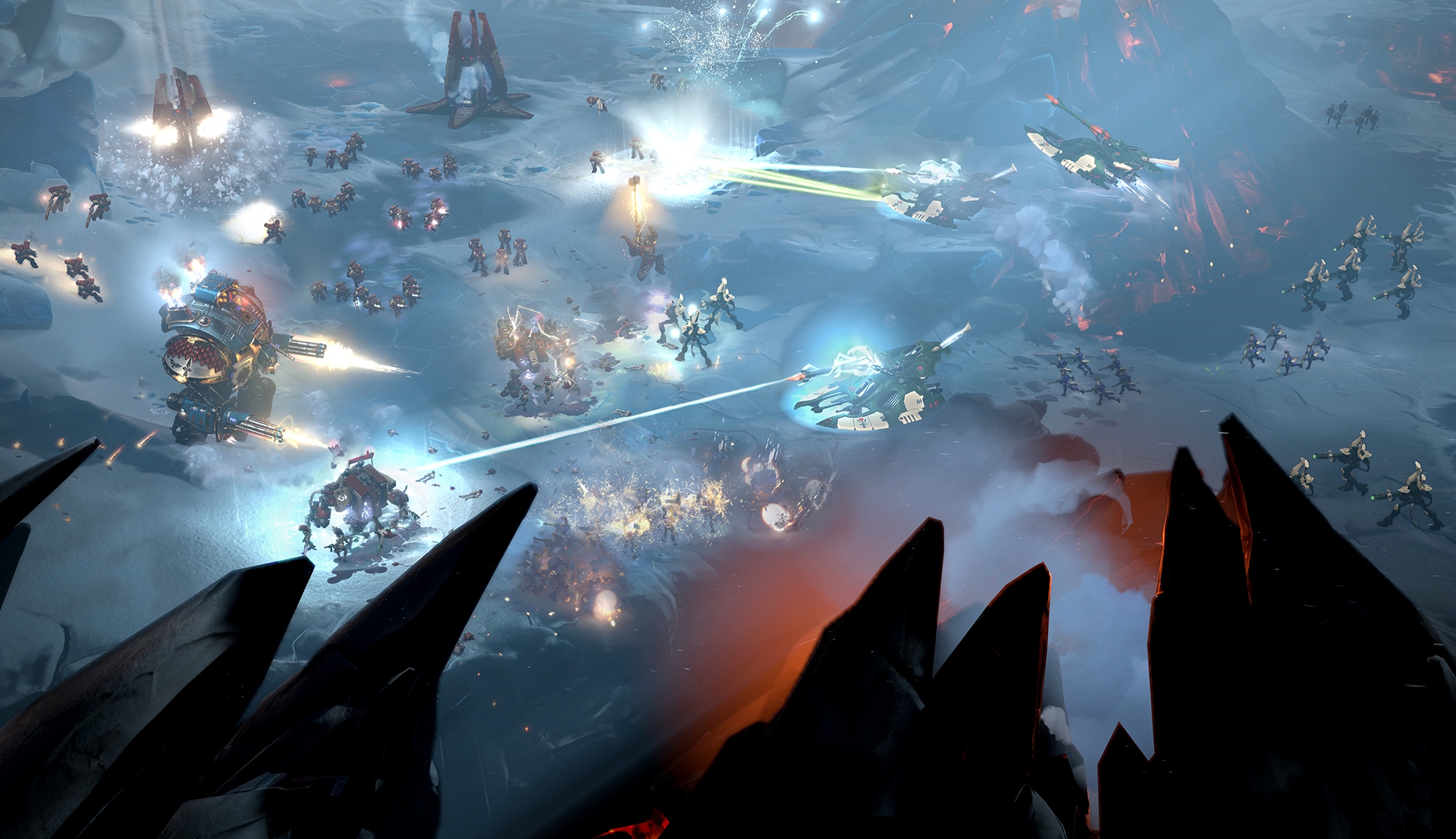
This post gave me much more hope of expecting a balanced, satisfying and innovative game, excellent!
LikeLike
Nice article. There is so much depth to the thought and development of these titles. This team has made an engaging world and I look forward to checking out this title.
LikeLike
well. At least some article that really explains things. Thnx for posting it.
I still would have prefer Relic deliver a COH-DOW2 gameplay instead of a Starcraft one but at least they are trying to make a real new game for the serie.
I still have issue with how they ignore community feedbacks and their TOTAL lack of communication with the community.
Only 3 factions, Gabriel doing saltos in the air, lack of clarity because effects, cartoony units and poor animations: I really tried but I just can’t deal with it. I hope the other players can so we shall see a DOW4 someday.
I LOVED DOW2 but DOW3 will be without me….
LikeLike
Nice review, it also explains their the thoughts behind their decisions, which is great. I also realized that DoW3 covers a lot of issues of the RTS Genre, which you mentioned in your “What RTS Games could learn from MOBAs”
LikeLiked by 1 person